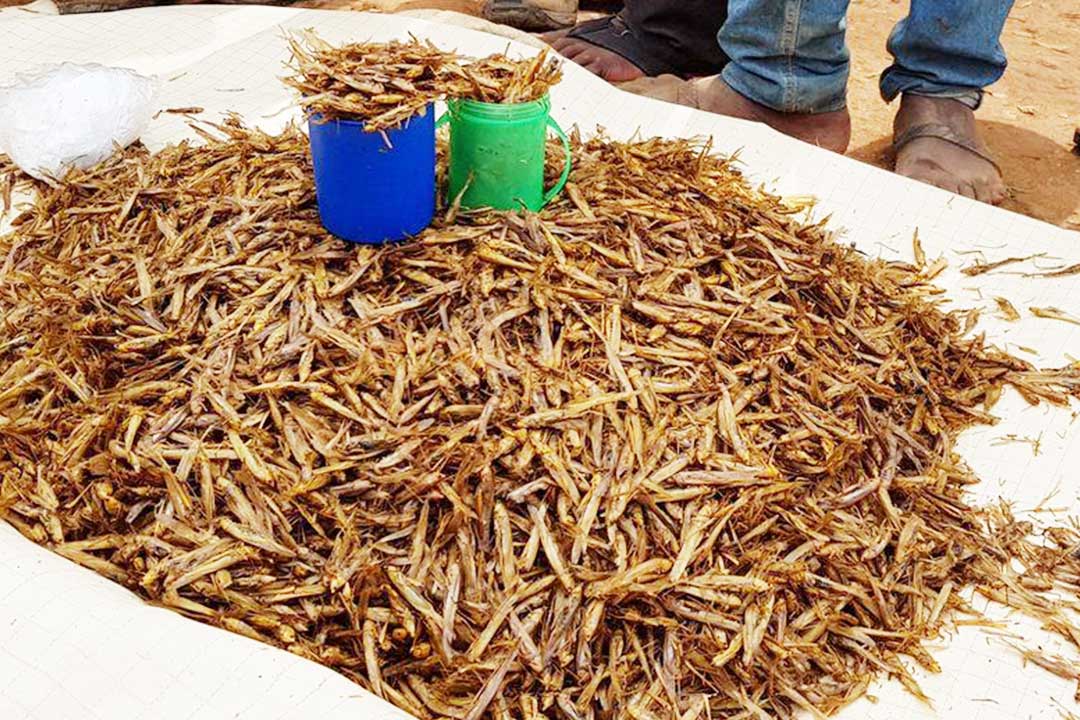Families gathered in villages; sharp business people took loans from banks to pay electricity bills in advance, buy the oil barrels in which they’d be trapped and shiny iron sheets to attract them; herders and school-going children took occasional breaks from the duties to give these green and ashy-brown insects a chase.
In 2021, however, the much-anticipated nsenene was almost a no-show in Uganda. He who had/ate them considered themselves lucky. So scarce, they were vended on a Uganda Airlines flight to Dubai, causing a major controversy.
Even the locals in Masaka – the self-proclaimed nsenene City are nursing losses and huge loan deficits due to the short supply.
Twaha Kavuma, 34, has been a player in the grasshopper business for eight years. During the grasshopper season, his group of 14 youngsters run at least seven grasshopper harvesting sites in Nyendo, on the outskirts of Masaka City.
In a good season, he made not less than Ushs 17m (US$4,700) in profits. This time around, he could not even manage to squeeze out Ushs3m (US$850).
“Due to the scarcity, we increased the prices from Ushs3,500 (US$0.60) a plastic cup to Ushs5,000 (US$1.4), but the demand remained higher than the supply. Eventually, the prices went up to Ushs10,000 (US$2.81) for ready-to-eat grasshoppers and Ushs7,000 (US$1.97) for the fresh ones,” Kavuma bemoaned.
In other parts of Uganda, especially in the Capital, Kampala, the price of grasshoppers quadrupled Kavuma’s quotation. Carrying a cup of grasshoppers around attracted more risk of robbery than carrying an iPhone.
This scarcity has puzzled scientists and culturalists alike. Grasshoppers aren’t just a delicacy. In the Buganda Kingdom, they are a cultural symbol after which a whole clan is named. Before the Gregorian calendar became a thing, our ancestors used to identify November and December as ‘Museneene.’
It’s how they planned their planting, predicted rain patterns, and ‘blasted’ during the festive season.
So why is Uganda and the other countries in the region experiencing a reduction in grasshopper supply, and what can you do to avert the situation?
Climate change
Let us start with the science; researchers from Texas A&M University and Museo De La Plata in Argentina agreed after studying the DNA of 142 species in 22 countries that grasshoppers originated from South America.
Over the last 59 million years, grasshoppers migrated to Africa in the quest for grasslands that form the chunk of their diet. In return, Africans have made them a delicacy.
However, due to increased desertification in North Africa, grasshoppers would migrate southwards often during the rainy seasons following the winds from the Indian Ocean. Masaka became the ‘Nsenene Capital’ because of the breeze from Lake Victoria – the second largest freshwater body in the world and biggest in Africa.
The cover provided by the Lwera swamp gives the revered insects an excellent habitat to feed, breed and multiply. The same can be said about areas surrounding Lake Albert, whose breeze pushes the insects towards Hoima, another grasshopper source.
For example, in Masaka district, over 15,000 hectares of wild habitat were converted into farmland or for settlement use between 1990 and 2015. Most of the Lwera swamp has been converted into rice plantations and sand mining installations.
It is no wonder that the Masaka-Mbarara highway caves in towards Lukaya town every year towards the festive season.
Loss of forest cover and wetlands
Given the rate at which Uganda’s forest and wetland cover is disappearing, it is not a stretch to say that you could be eating the very last grasshopper.
Data from the National Forestry Authority indicates that at least 10% (1.9 million hectares) of Uganda’s land is covered by gazetted forests. However, from 2002 to 2020, Uganda lost 67.9kha of humid primary forest, making up 7.6% of its total tree cover loss in the same period, according to the Global Forest Watch.
This means that the total area of humid primary forest in Uganda decreased by 13% in this period. The forest cover that sandwiched the road towards Bukakata Port on the shores of Lake Victoria is now a pineapple farm, Mabira forest is now half sugarcane, half trees and the Bugoma forest scandal has been widely publicised.
The heatwave and desert locusts
At a global level, the prolonged heat wave occasioned by the increase in ocean temperatures and rare cyclones has changed climate patterns in Eastern Africa. As a result, instead of seeing more grasshoppers, it was their ruthless cousins – the desert locusts that showed up instead, ravaging everything in their path.
And they’re not done yet. Experts have warned of more desert locust invasions if there is no urgent action to reduce the earth’s temperature as per the COP 26 agreement.
“If we see this continued increase in the frequency of cyclones, I think we can assume there will be more locust outbreaks and upsurges in the Horn of Africa,” Keith Cressman, FAO’s Senior Locust Forecasting Officer, told National Geographic.
Want to save grasshoppers? Here’s what you can do
First, let us plant some more trees. The grasshopper population can only increase with the restoration of the forest cover we have depleted for human settlement, charcoal, firewood, commercial agriculture, among other reasons. The Last Drop Africa will be championing tree-planting campaigns in all regions of Uganda by giving away 2 million trees per region.
Secondly, desist from using cooking methods that put more pressure on trees and cause deforestation. Cooking with charcoal and/or firewood is one of the leading causes of deforestation. Additionally, research shows that exposing children to smoke from such cooking increases their likelihood to get pneumonia. Over 500,000 deaths from the disease are caused by household air pollution.
Finally, embrace artificial grasshopper breeding. A group of Ugandan scientists led by Prof Phillip Nyeko, the top honcho in the Department of Forestry, Biodiversity and Tourism at Makerere University, experimented with grasshopper rearing in a controlled environment. They concluded that it is possible to rear the delicious insects at home while saving the biodiversity of mother nature.
Image credit: BBC

